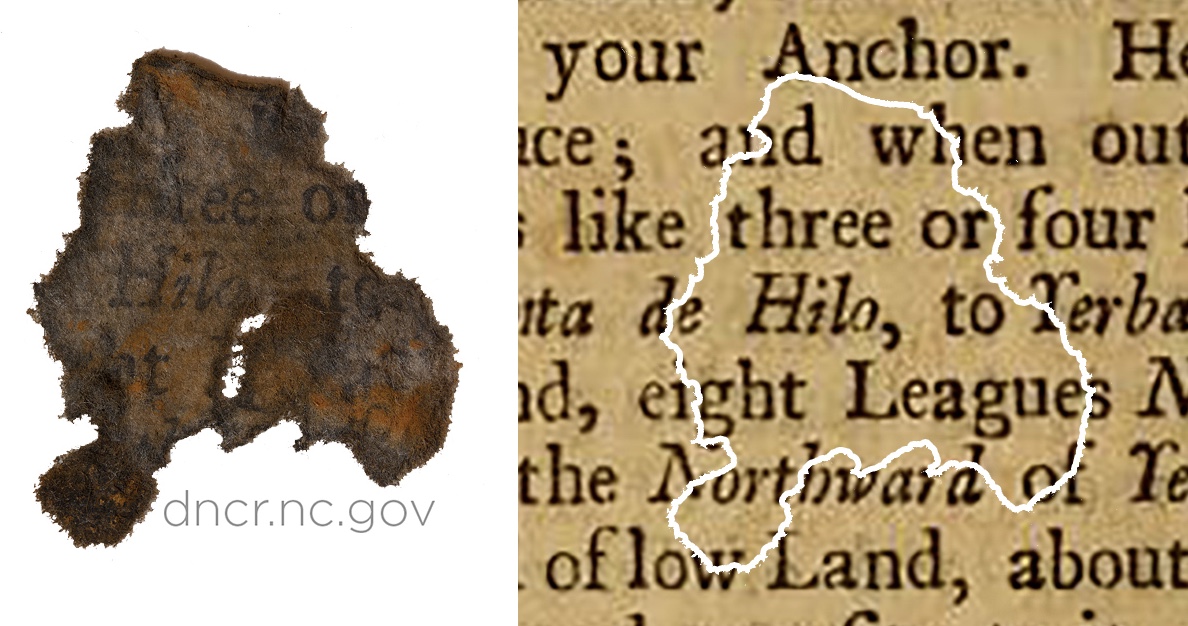Blackbeard's Book Club? Document Discovery May Reveal Pirate Reading List

NEW ORLEANS —A discovery from the wreck of Blackbeard's shipcould offer some insights into pirate reading tastes.
Conservators in North Carolina found paper fragments wadded up inside a cannon chamber that was pulled up from the wreck of Queen Anne's Revenge, the flagship of the infamous 18th-century pirate Blackbeard. The pages had been ripped from a seafaring adventure tale that inspired the novel "Robinson Crusoe."
The discovery was announced here yesterday (Jan. 4) at the annual meeting of the Society for Historical Archaeology.
Blackbeard, whose real name was Edward Teach (or Thatch), was an English pirate who terrorized merchant ships in the Caribbean and along the Atlantic coast of North America during the early 18th century. [See photos of the text from Blackbeard's ship.]
His flagship ran aground on a sandbar along North Carolina coast in 1718. Later that year, Blackbeard was hunted down and killed by the Royal Navy. In 1996, the wreck of his hijacked ship was rediscovered. The ship has been under excavation by the Queen Anne's Revenge Project, with divers discovering weapons, the ship's bell, medical supplies and hundreds of thousands of other artifacts.
Conservators were recently examining a concreted metal piece of a breech-loading cannon that had been recovered from the wreck. When the conservators pulled out a wooden plug that was sealing the cannon chamber, they found some wadding (material used to seal gas behind a projectile), which looked like "a mass of black textile," said Erik Farrell, a conservator with the North Carolina Department of Natural and Cultural Resources' Queen Anne's Revenge Lab. [Photos: The Medical Instruments Found on Blackbeard's Ship]
Once the black sludge began washing out of the waterlogged material, conservators could see a little bit of legible text, and they realized they were dealing with a printed document.
Sign up for the Live Science daily newsletter now
Get the world’s most fascinating discoveries delivered straight to your inbox.
"This is not something we typically find on an underwater site," Farrell told an audience here.
Farrell said he contacted other expert conservators and learned that he needed to get the paper dry within 48 hours if he wanted the document fragments to survive. After the emergency conservation effort, the researchers started transcribing the text on the 16 tiny pieces of paper.
They could make out only a few words and phrases, such as "South of San," "(f)athom" and "Hilo." They decided to use "Hilo" as their primary search term to find a match with a known piece of text. Hilo was not a very common name, and most likely referred to the city of Hilo in Peru.
After a yearlong search for a match, Kimberly Kenyon, another conservator with the Queen Anne’s Revenge Lab, finally spotted a similar reference to Hilo this past August in the 1712 first edition "A Voyage to the South Sea Around the World."
"Everyone crowded into my office and we started matching all the fragments we had," Kenyon told Live Science. Ultimately, the researchers matched seven of the 16 fragments with parts of the book.
The text details the real-life experiences of author Edward Cooke aboard the Duchess, one of the two ships commanded by British Capt. Woodes Roger, in a British privateering voyage from 1708 to 1711 against the Spanish. This was the expedition that rescued marooned sailorAlexander Selkirkfrom an uninhabited island in the South Pacific, and the account is thought to be an inspiration for the fictional Robinson Crusoe.
"By the early 18th century, there were several voyages into the South Seas and a lot of voyage narratives written," Kenyon said, adding that the "English public was just eating these stories up”about the “romanticism of the high seas and plundering Spanish holdings."
Farrell, Kenyon and their colleagues are still trying to figure out how the book ended up on Blackbeard's ship. The text could have been part of the library of one of the ships that Blackbeard and his crew plundered, such as the merchant sloop Margaret. It is also possible that the book was a personal item of one of Blackbeard's 300 crewmembers.
"Given the levels of literacy among English sailors at the time, it could belong to any member of the crew there," Farrell said.
How the pages came to be used as wadding in the cannon is another mystery. The book might have been grabbed at random in the heat of battle and its pages torn out, but perhaps there was a political motivation behind the selection of a book about Woodes Rogers' expedition.
Rogers became the first British governor of the Bahamas and led a crackdown on pirates. It's "speculative and unprovable," Farrell said, but nonetheless intriguing to wonder if someone on the crew was "deeply unhappy with Rogers' political and career trajectory."
Around the time Rogers arrived in the Bahamas, Blackbeard left the Caribbean. "We're starting to formulate ideas about whether these two men knew each other," Kenyon said. "Were they connected somehow? Did Woodes Rogers' arrival spark Blackbeard's imminent departure? Was this act of tearing up a book of his a statement of some sort?"
Editor's Note: This article was updated with comments from one of the researchers.
Original article on Live Science.











